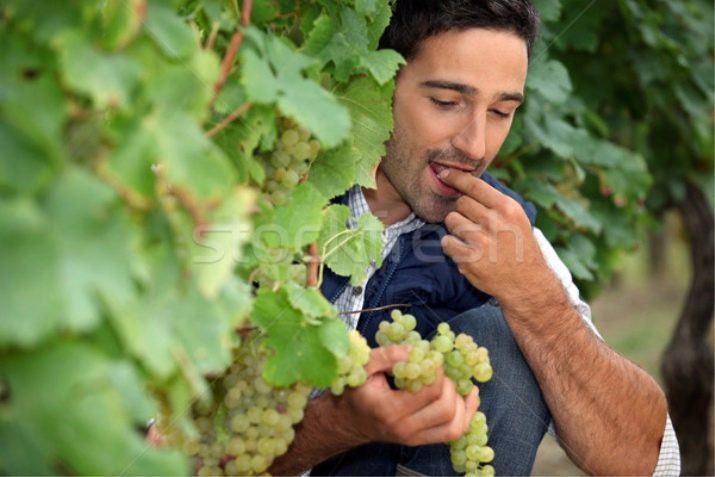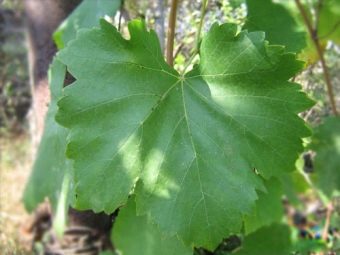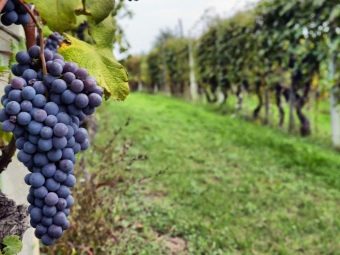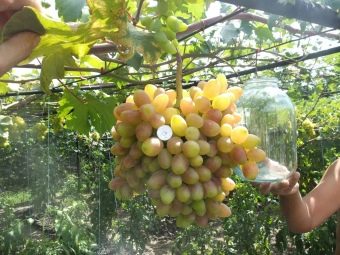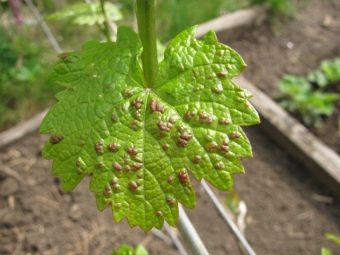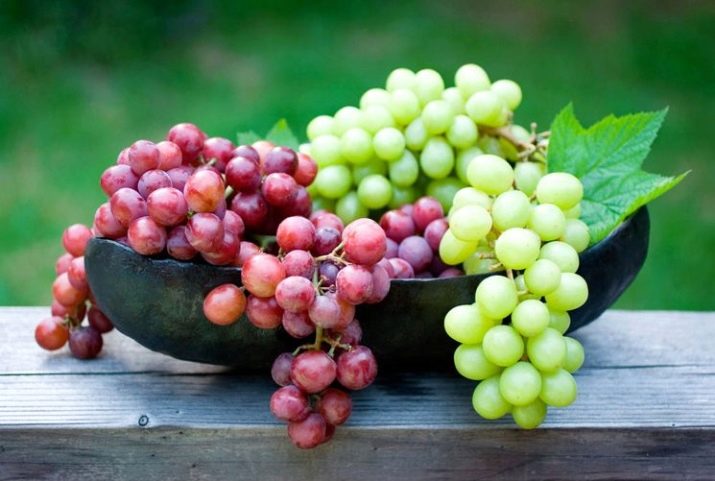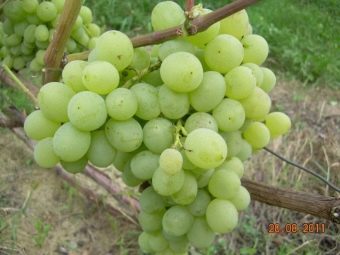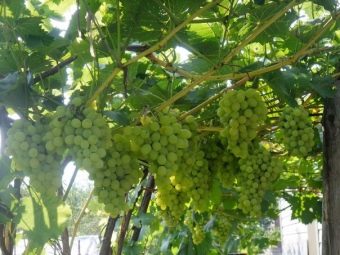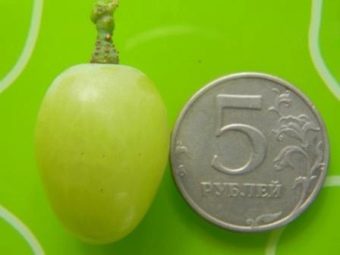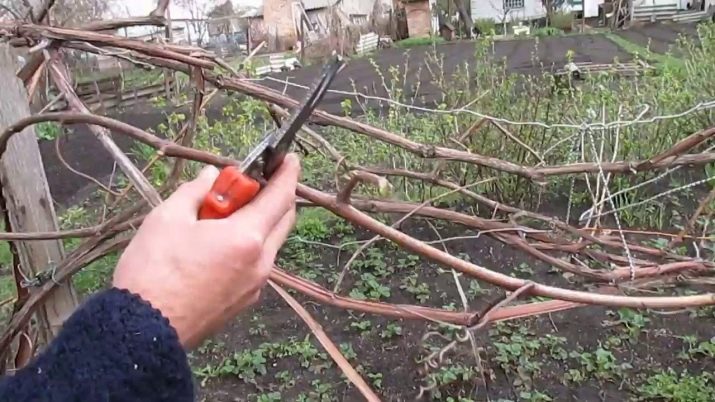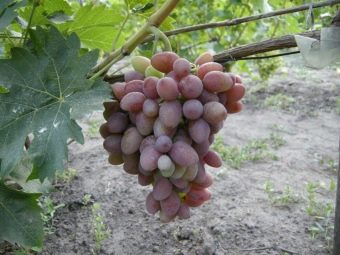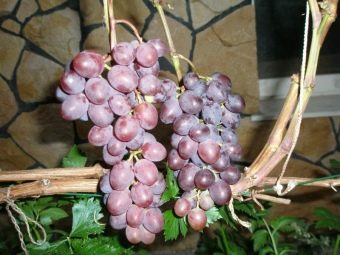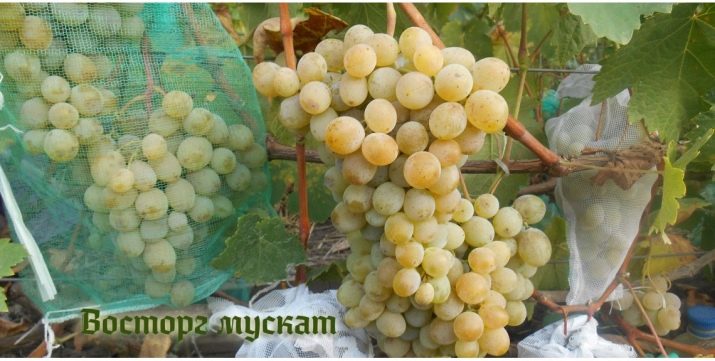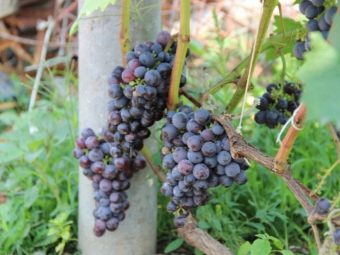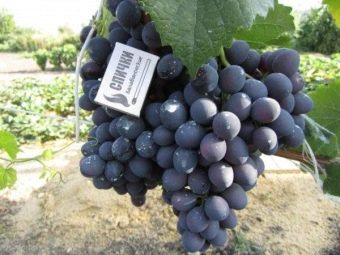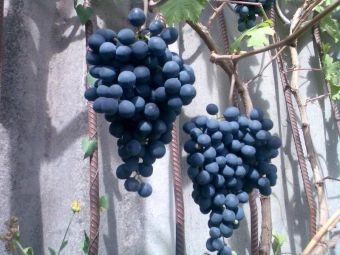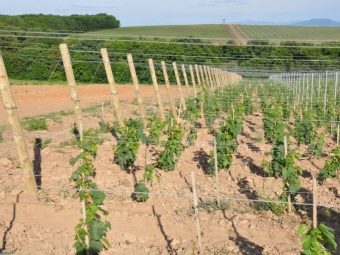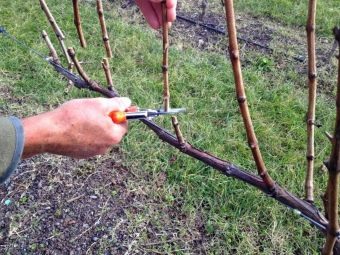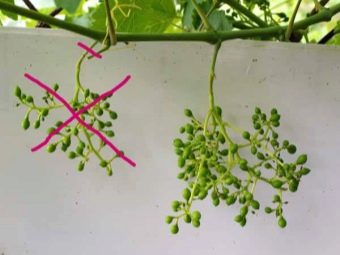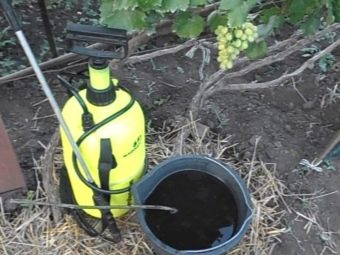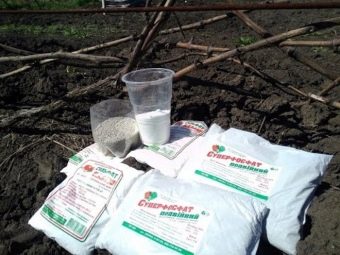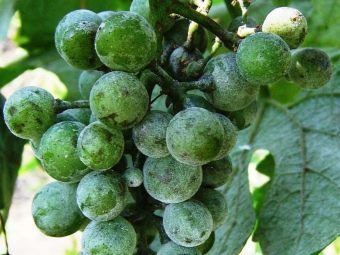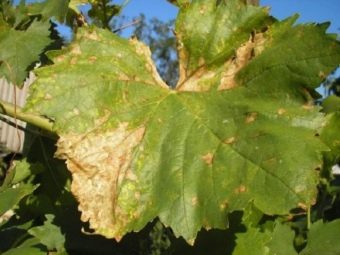Grapes "Delight": characteristics and modifications of the variety
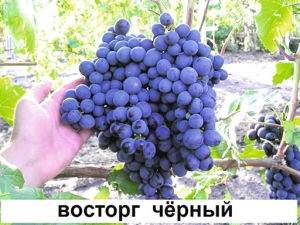
Growing grapes is a special occupation.The waiting time for the first harvest is estimated at 3-4 years of hard work. But if you choose the right variety and will carefully care for the crop, you will definitely have a bountiful and tasty harvest.
Grapes "Delight" - one of the most popular varieties. This article will tell you about the characteristics and modifications of this species.
Interesting about grapes
Grapes can rightly be called a long-liver among berry bushes. Cultivars live 50-60 years, and the age of wild can reach 400 years. There are more than 20 thousand varieties and hybrid forms of grapes around the world, and this number is constantly increasing.
The energy value of grapes is very high. It is known that 1 kg of its berries is equivalent to 230 g of bread, 380 g of meat, 1 kg of potatoes and 1 liter of milk. Research has shown that a person can eat grapes for 90 days.
Features of the variety
Both experienced gardeners and beginning gardeners often wonder which grape is best to cultivate. There is no single answer to this question. The choice of variety depends on the climatic conditions of the area and the preferences of the grower. However, there are varieties with quite high viability and a huge number of hybrid forms that feel great both on the slopes of the Crimean vineyards and in the harsh climate of Siberia.
Such delightful qualities are possessed by the “Vostorg” grapes, bred by J. Potapenko, I. Kostrykin and A. Skripnikova as a result of the selection of the varieties “Dawn of the North” and “Dolores”, and at the next stage - with “Russian Early”. "Delight" self-pollinated. Annual shoot growth is 2.5 meters. The branches are medium to strong. The leaves are heart-shaped with jagged edges, they are not very large, but not small. Rhizome deepens into the ground by 2 m.
Advantages and disadvantages
The indisputable advantages of "Delight" can be called a few points.
- High frost resistance. Initially, it was bred for cultivation in the territory of the steppe Ukraine, but gradually its subspecies spread in various localities, from Siberia to the Crimea.
- Good, stable fruiting and coarse. From 1 hectare you can collect 12,000 kg of crop. In this case, one berry weighs from 5 to 10 g, and the whole bunch - from 500 g to 1.5 kg.
- Early ripeness. Vegetation period "Delight" lasts 115 days. Massive cone-shaped, indefinite forms of grapes ripen from the middle to the end of the summer (from July to August, sometimes from July to September).
- Excellent taste characteristics. The flesh of the berries is juicy and sweet (up to 26% sugar content).
- Preservation of freshness and elasticity of berries for a long time. Fruits without damage can remain uncollected for 2-2.5 months, and in vineyards until January.
- Immunity to Botrytis cinerea and minimal risk of cracking berries.
However, this variety also has vulnerabilities:
- it is affected by phylloxera;
- he needs constant spraying to withstand oidium;
- the frost resistance of all types of Delight is limited to -25 ° C or -27 ° C (at lower temperatures, 20-30% of central buds freeze over).
Kinds
“Delight” is rich in the genome of the variety, which made it possible to create on its basis a whole family of hybrid forms. Seri them: FVO-7-5, "Tuzlovsky giant", "Nina", FVB-8-3, AIA-2, "Ataman", "Reliable", "Super-Bezh", "First-Called", "Rosalia 08sp- 30 "," Rizamat stable LMsp-72 ", etc. Five of these are the most common:
- “Oval Delight” (Baklanovsky);
- “Perfect Delight” (Perfect);
- “Red Delight” (AIA-l, AIA);
- “Muscate delight” (Super wound Delight);
- “Black Delight” (216-29-10-1).
"Oval Delight" (Baklanovsky)
This variety has strong-growing bushes with carved leaves. Inflorescences are formed on the bottom of the shoots. Plants are recommended to grow on trellis supports. "Delight oval" thermophilic. It is good for cultivation in southern areas, planting in the northern areas is contraindicated. The berries have an elongated egg shape with a whitish tinge.
Culture requires mandatory double pruning in the fall and spring. In the fall, shoots are shortened by 8-10 buds, leaving only 40 buds, but without affecting the ovary at the very bottom of the trunk. It breaks out during the spring processing of the vineyard so that the clusters do not touch the ground, and the space between the vines is well blown.
"Perfect Delight" (Perfect)
This species has large white oval-shaped berries with a light tan, the weight of which is 5-6.5 g. The weight of one bunch of “Ideal” reaches 1200 g. The sugar content is from 19 to 26%, the acidity is 5-9 g / l The growing season lasts just over 120 days. Culture tolerates a drop in temperature to -26 ° C, resistance to powdery mildew is 2.5-3.5 points.
For this type of "Delight", a high-shtamping shaping is recommended. Cultivation on arches and arbors is also welcomed. In order to avoid problems with fruiting, for 4-5 years (during the formation of the bush) the correct pruning and distribution of the shoots is necessary.
A grape-arbor will please the eye if you follow a specific sequence of actions. First you need to form 3 sleeves (vines) - two horizontal and one vertical. If the bushes were planted in the spring, the form is laid in the autumn. The length of two horizontal shoots is determined as follows: they look to see if the vine reaches the first wire row and 4 more ovaries are left.
In this case, the vertical vine must be shortened to the level of matured wood. With the onset of spring, all the vines are fixed on the wires of the arbor, and the kidneys from the bottom are removed. On the shoot, located vertically, 3-4 eyes are left on top. These shoots without buds will eventually build up wood, turning into a strong base (bush sleeves).
In the fall, pruning is repeated again, according to the algorithm of the previous year. Over time, when the vine reaches the top of the arbor, it is necessary to separate the two sleeves to the side. In the 6th year of bush growth and further, traditional pruning is applied to the horn, leaving so many branches that the total number of ovaries on them reaches 35-45 pieces.
If you leave less, the next crop will be too bulky and heavy.
"Red Delight" (AIA-l, AIA)
This species has a pink-red ovoid-oval fruits, rather large (from 6 to 8.5 g). Accordingly, clusters are heavy (from 550 g to 800 g). Sugar content - from 18% to 23%, acidity is 6-8 g / l. According to the maturation period, the variety is early average. It withstands cold temperatures up to -24 ° C, resistance to mildew - 2.5-3 points.
Bushes AIA-1 sredneroslye. The recommended landing area for each bush is 6 m2. When autumn processing fruit buds lay only ½ of the shoots, 8-14 eyes. In the total mass leave no more than 40-55 buds. For the cultivation of this variety on the arches and gazebos in the fall perform traditional pruning on the horn. The volume of the mass of leaves and fruits is normalized in the summer.
“Muscate delight” (Super wound Delight)
The following features are inherent in “Muscate delight”: the fruits are large, oval, light, with an amber gleam and nutmeg aroma. Clusters in ripe form are large, weighing from 400 to 700 g. Sugar content of berries is high - from 19% to 26%, the level of acidity is from 5 g / l to 9 g / l. Enthusiasm muscate frost resistant, does not freeze out even at -27 ° C. The term of ripening is very early - 115-110 days. Resistance to powdery mildew - 3-3.5 points.
Bushes "Delight muskatnogo" vigorous. Their yield is quite high: 80-95% of the vines bear fruit. Therefore, it is necessary to constantly monitor the fruit load of the bushes. In the autumn, only 20-25 buds are left on each plant; in the summer, the volume of green mass and grapes is rationed.
This variety of "Delight" is comfortable in sandy soil. It can also be grown on arches and gazebos.
“Black Delight” (216-29-10-1).
This species is also known as the "Brother of Delight" and "The Black Baron". This is a table grape variety.The dark blue large berries of Delight Black form heavy clusters, the weight of which ranges from 450 to 750 g. They have not very high sugar content - from 16% to 18% and acidity from 5 g / l to 9 g / l. The grapes ripen in 115-125 days, its mildew resistance is 3-3.5 points. The variety is frost resistant, withstands temperatures down to -25 ° C. By Botrytis cinerea it is unstable.
In the Delight of the Black, as well as in the Red, the flowers are only of the female type. You can pollinate them if you plant grapes with flowers of both sexes in the immediate vicinity.
The structure of the berries of this grape variety is elastic. The flesh is sweet, juicy, slightly knitting. Since “Black Delight” is distinguished by high fruitfulness (75-85% of shoots are fruit-bearing), large gaps between the knots are left during spring processing. Compliance with these rules allows you to get about 240-250 centners of yield per hectare.
If it is supposed to cultivate the grapes in a cold climate, then it is necessary to provide additional shelter for the winter period. This variety can be grown in Belarus, Ukraine, the Urals, Moldova, Siberia.
Landing
All varieties of grapes "Delight" have some general principles of planting and care. Grapes - sun-culture, so plant it better in the southern areas and on small elevations with good air flow. Loamy soils, black soil, sandy loam are best suited for “Delight”.
All varieties of this variety are propagated by seedlings, layering, rarely seeds (as a rule, only in the selection process, because in this embodiment the seedlings do not have the properties of the parent bush). Each low-growth or medium-growth bush requires an area from 3 to 4 m2, a high-growth one - up to 6 m2. The plant develops well in gazebos and in the wall space.
When planting several bushes, the distance between the pits should reach 4-6 m, and it is necessary to retreat 2 m from buildings and various structures. It is recommended to dig out the pit for planting in advance and cover the bottom with earth mixed with compost. The size of the recesses should not exceed 60-70 cm in length and 90 cm in depth.
Planting seedlings in prepared pits is made in a month. The sapling is set in the center, watered and sprinkled with earth. The soil near the plant is covered with a mixture of sawdust wood, peat and straw.
Care
“Delight” is considered to be a rather unpretentious crop, but in order for the bush to grow and grow, and the vines to bear fruit, it is still necessary to provide constant care: adjust the green volume of the vineyard in time, irrigate, feed and treat pests and diseases.
The regulation of the green volume of the bush includes the following operations:
- a piece of excess shoots;
- pinching the tops of the branches;
- elimination of stepsons;
- coinage;
- banding;
- elimination of leaves under bunches;
- removal of excess and too small berries in clusters;
- elimination of shoots.
This variety loves plentiful watering. Good soil moisture allows you to increase the weight of the fruit and the overall yield of the crop by 30-40%. For more abundant fruiting grapes also need to feed organic and mineral fertilizers. Organic supplements are rarely applied (once every 2-3 years), mineral more often (once a month), usually with water when watering. The main elements for the life of the bushes are three components.
- Nitrogen. Thanks to nitrogen, all parts of plants grow and develop. With its lack of growth slows down, the leaves die off, clusters are not formed. Nitrogen-containing supplements: calcium nitrate, ammonium nitrate, urea, ammonium sulphate.
- Phosphorus is a constituent element of grape pollen. It speeds up the process of the appearance of colors. Red-purple formations on the surface of the leaves - a sign of lack of phosphorus. The most commonly used superphosphate and double superphosphate.
- Potassium promotes the development of plant immunity to frost and dry periods of the year, diseases.If there is not enough potassium, the leaves of the grapes become faded, pale, their edges die off. Top dressings containing potassium: ash, potassium salt, potassium sulfate.
Despite the fact that "Delight" is a frost-resistant culture, young seedlings require careful care and shelter during the cold season, especially if they are planted in the fall. Also, grapes require constant spraying to minimize the risk of powdery mildew. As a rule, spray bushes three times:
- the first time occurs when the shoots reach 20-25 cm (in the middle of May);
- the second anticipates flowering and is held in early June;
- the third is carried out when the berries reach the size of a pea.
In the spring and autumn, the bushes are processed to protect against oidium.
Reviews
Judging by the reviews on the Internet, “Vostorg” grapes have proven themselves well among both beginners and experienced growers. However, practice confirms that before planting this variety, it is necessary to carefully study the recommendations for planting and care, so as not to be disappointed in the culture in the future.
Review grapes "Delight", see the following video.

